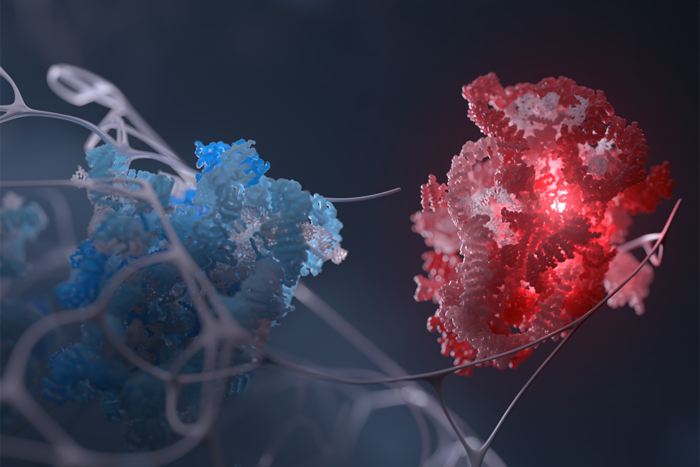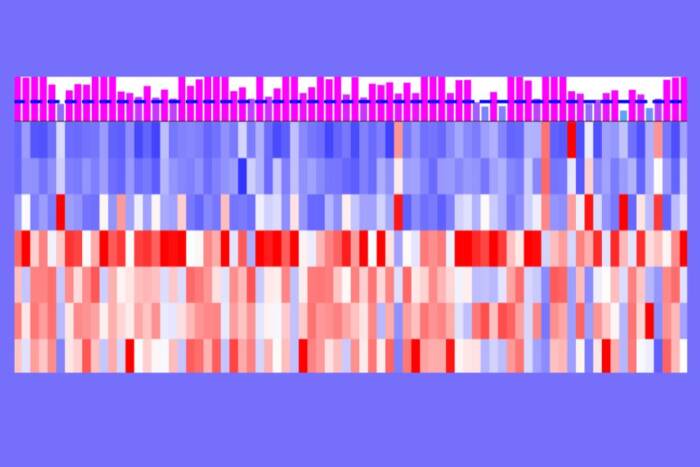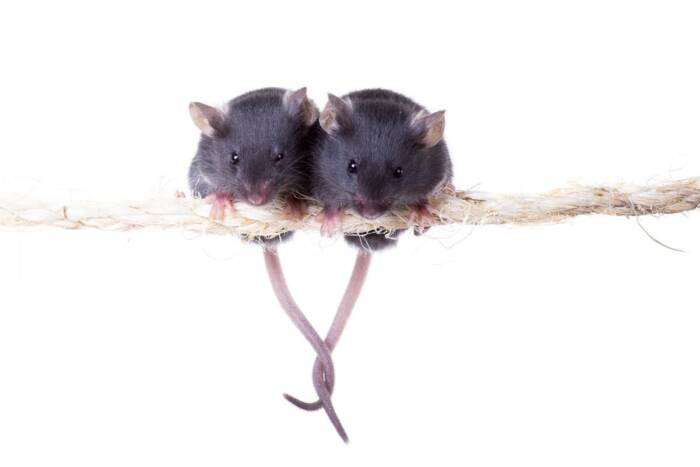One gene, two important proteins
Researchers discover gene variation in cancer-causing “STAT” family encodes two —not one—functional proteins

James E. Darnell and colleagues have discovered that the development of a fly's body depends on more than the activity of its one and only "STAT" gene. It also depends on the inhibitory function of a second STAT protein coded for by the same gene locus. To show this, the researchers used developing fly embryos. Normally, an embryo will develop eight regular body segments (top). When the researchers artificially removed both forms of the STAT protein, a fusion of two of these segments occurred (middle). Surprisingly, when only the original STAT protein was removed, a more severe defect affecting not only the body segments but the head and tail as well, was seen (bottom). These experiments demonstrate that the new STAT is indeed a negative regulator, or inhibitor, of the originally characterized STAT protein.
When the Human Genome Project first revealed last year that humans possess only an estimated 30,000 genes — fives times more than a mustard weed plant — the fact that many of our genes code for more than just one protein assumed greater importance. Such protein variations, researchers reasoned, must play an even larger role than previously thought in contributing to the remarkable complexity of human beings.
This notion has been supported recently by Rockefeller University scientists, who report the discovery of a novel protein variation within a single fruit fly gene, or “gene locus.” They show that the fly’s one and only “STAT ” gene locus — the human counterpart of which plays a role in cancer — codes for two, not one, important proteins. In addition, the researchers find that the function of this second protein is to inhibit the activity of the originally characterized STAT protein.
“In this postgenomic era, findings like this one make it more and more clear that alternate proteins, or protein isoforms, should be considered when attempting to explain complex biological phenomena,” says James E. Darnell Jr., Ph.D., principal author of the report published in the Sept. 15 issue of Genes and Development.
The discovery of an inhibitory STAT protein suggests possible novel treatments for the approximately 50 percent of human cancers in which STAT proteins are known to be overactive. These include leukemia, breast cancer and head and neck cancer.
Other authors of this research paper include first authors Melissa A. Henriksen, Ph.D., and Aurel Betz, Ph.D., and second author Marc V. Fucillo, all at The Rockefeller University. Darnell is the head of the Laboratory of Molecular Cell Biology at Rockefeller and co-author of the popular textbook Molecular Cell Biology.
The STAT genes, first identified by the Darnell laboratory in 1992, code for a set of proteins that help cells throughout the body to interpret and respond to dozens of incoming chemical messages. They are found in a variety of organisms, from slime molds to humans, and are essential to many aspects of life, including growth and immunity.
Yet, despite their versatile nature, only a handful of STAT genes are known to exist: seven have been identified in humans, four of these by Darnell’s group, and just one has been found in flies, also by Darnell and colleagues.
One of the key questions in biology is how a single gene or a limited set of genes, like the STATs, can respond to such a diverse array of molecular signals with an equally diverse set of biological outcomes. The new research provides one answer by not only identifying a second protein encoded within the only STAT gene locus in flies — but by showing that it has an important inhibitory action on the original STAT protein and its various roles in developmental events.
Moreover, this particular finding marks a first in the field of STAT research. “Though an increasing number of other types of STAT inhibitors have been identified, this is the first time a functional one has been found within the STAT gene itself,” says Henriksen.
Molecular Transmitters
A lone liver cell placed into a petri dish will lose its identity, while a liver cell living among its own kind will thrive. Darnell first observed this phenomenon in the early 1980s and concluded that molecular cues from a cell’s natural environment must control the production of tissue-specific proteins. The next big question was how.

Aurel Betz (left), Melissa A. Henriksen and James E. Darnell discovered a novel inhibitor of "STAT" gene activity in flies within the gene itself.
Over the next decade or so, he and colleagues provided more than an answer by mapping out the first complete “signal transduction” pathway. They showed that an incoming molecular message, such as a polypeptide hormone or cytokine, binds to a receptor located on the outside of a cell, which leads to the activation of a “kinase” enzyme called “JAK.” JAK, in turn, activates the STAT proteins (“Signal Transducers and Activators of Transcription”), which subsequently travel to the nucleus, bind to specific patches of DNA and switch on corresponding genes — the end result being the production of new proteins.
Today, scientists know that the JAK-STAT pathway faithfully relays the messages of at least 40 different molecular signals, including interferon, growth hormone, prolactin, erythropoietin and most of the interleukins — and thus constitutes one of the body’s primary means of communicating with its vast multitude of cells.
What happens when this communication goes awry was demonstrated by Darnell, Jacqueline Bromberg, Henriksen and other colleagues in 1999. They showed that a human STAT protein, called STAT3 — which is overactive in various human tumors — can by itself turn normal cells into cancerous ones. The finding marked STAT3 as an official “oncogene” and solidified the notion that drugs designed to block the action of STATs may prove beneficial to cancer patients.
Two for Price of One
According to the Central Dogma of biology, DNA codes for a messenger molecule called RNA, which then codes for proteins. Since the late 1970s, scientists have known that the standard unit of DNA — the gene or gene locus — can and often does code for multiple functional proteins. This variation in coding ability comes from alternate RNA “start” sites or alternate splicing choices — that is, choices in the way RNA is processed into a protein. However, these alternate proteins, or protein isoforms, have perhaps not received as much attention as they deserve.
In the new study, the researchers discovered that the only known STAT gene in flies, called Stat92E, codes for a second, shorter protein in addition to the originally characterized, longer form. They then found that this new, short protein is missing an important region of the long protein — the same region required for its activity. This finding led them to ask if the purpose of the short protein was to inhibit the action of the long by usurping its molecular targets.
This type of inhibition, known as a “dominate negative,” may be better understood by picturing a key unable to open a lock because another broken one is jammed inside: the broken key (short protein) prevents the right key (active protein) from opening the lock (activating molecular targets).
To test this theory, the researchers turned to developing fly embryos. Normally, a fly embryo develops in a segmented fashion: seven stripes containing a protein called “even-skipped” form along the length of its body, dividing the embryo into eight segments. From previous experiments, the researchers knew that a defective Stat92E gene will cause these stripes, and thus the body segments, to disappear and the resulting larvae to become irregular.
As predicted, when the researchers overproduced the short STAT92E protein — or when they reduced the amount of the long STAT92E protein — the embryo’s body segments disappeared. These experiments, reported in the current Genes and Development, demonstrate that this new, alternate STAT is indeed a negative regulator of STAT92E activity.
In the same paper, they also showed that the ratio of the short to the long protein changed significantly as the fly developed.
“This kind of variation in overall STAT activity immediately suggests a mechanism by which one STAT gene can control so many different processes,” says Betz.
Currently, the researchers are testing whether this same mechanism is conserved in humans. Says Darnell, “It seems unlikely that such a potentially valuable mechanism of gene regulation would be discarded in evolution.”v


